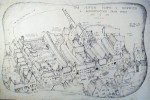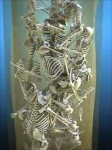 The remains of 17 bodies, 11 children and six adults, dating to the 12th-13th century found at the bottom of a well in 2004 were given a Jewish burial in Norwich’s Earlham Cemetery on Tuesday. The bones were picked up by a hearse from the Norwich Castle Museum where they’ve been in storage. They were placed in five coffins covered with tallits (Jewish prayer shawls), driven past the Norwich Hebrew Congregation Synagogue and to the Jewish Cemetery within the larger cemetery where local Rabbi Alex Bennet conducted a traditional Jewish burial service.
The remains of 17 bodies, 11 children and six adults, dating to the 12th-13th century found at the bottom of a well in 2004 were given a Jewish burial in Norwich’s Earlham Cemetery on Tuesday. The bones were picked up by a hearse from the Norwich Castle Museum where they’ve been in storage. They were placed in five coffins covered with tallits (Jewish prayer shawls), driven past the Norwich Hebrew Congregation Synagogue and to the Jewish Cemetery within the larger cemetery where local Rabbi Alex Bennet conducted a traditional Jewish burial service.
Bishop David Gillet, interfaith adviser to the Diocese of Norwich, eulogized the deceased and took the opportunity to express repentance for the ugly history of Christian antisemitic persecution, pledging to “live and work in our generation for supportive and respectful relationships between our two communities.” There’s film of the service in this ITV story.
It took a lot of work to get to this place. The biggest issue was whether the remains could be positively identified as Jewish. Although DNA testing performed by Dr. Ian Barnes on the BBC show History Cold Case indicated that five of the 17 people were members of the same family with origins in South-East Europe to Central Asia rather than Western Europe, that’s not conclusive proof of Jewishness. It’s certainly evidence, especially in the relatively ethnically homogeneous society of medieval Norwich, but there are other possibilities. They could have been the descendants of Roman soldiers or even the result of intermarriages between Christian pilgrims to the Holy Land and Middle Eastern locals.
 The circumstantial evidence supports the Jewish theory. The well in which they were found was adjacent to the Jewish neighborhood and why would 17 Christians, 11 of them children, be dumped down a dry well rather than buried in consecrated ground? Even plague victims were laid out in pits and they were infectious. Their sad fate smacks of the deliberate disrespect of a mob, and many Jews faced the business end of mobs between the Norman conquest and Edward I’s expulsion of the Jews from England in 1290.
The circumstantial evidence supports the Jewish theory. The well in which they were found was adjacent to the Jewish neighborhood and why would 17 Christians, 11 of them children, be dumped down a dry well rather than buried in consecrated ground? Even plague victims were laid out in pits and they were infectious. Their sad fate smacks of the deliberate disrespect of a mob, and many Jews faced the business end of mobs between the Norman conquest and Edward I’s expulsion of the Jews from England in 1290.
At any rate, the evidence was sufficiently convincing for Clive Roffe, Norwich representative on the Board of Deputies of British Jews, to campaign for the bones’ proper burial. Starting in 2011 after the BBC program aired, Roffe together with Bishop David Gillet and other members of the Jewish community and Christian clergy petitioned for the bones to be released from the Norwich Castle Museum “for decent and appropriate burial.”
 Museum authorities were initially reluctant. They wanted the bones to be available for further study and Alan West, curator of archaeology at Norwich Castle Museum, didn’t think there was any evidence suggesting they were Jewish. After more than two years of lobbying, the Board of Deputies persuaded the museum that no matter what their ethnicity, the bones should be respectfully buried and if the Jewish community was willing to accept them as their own based even on the mere chance that they were the remains of murdered Jews, then they should be allowed to take them in hand.
Museum authorities were initially reluctant. They wanted the bones to be available for further study and Alan West, curator of archaeology at Norwich Castle Museum, didn’t think there was any evidence suggesting they were Jewish. After more than two years of lobbying, the Board of Deputies persuaded the museum that no matter what their ethnicity, the bones should be respectfully buried and if the Jewish community was willing to accept them as their own based even on the mere chance that they were the remains of murdered Jews, then they should be allowed to take them in hand.
The board intends to erect a monument on the grave site indicating that the buried are thought to have been victims of a pogrom like the one in 1190 which took place in Norwich on the heels of an anti-Jewish massacre in York. The bodies will also be commemorated on a plaque in St. Stephen’s church which will quote the Hebrew scriptures.
Meanwhile the attempt to narrow down who these 17 people were continues. Dr. Joachim Burger of Mainz University in Germany, a top expert in the field, is in the process of analyzing the DNA. He won’t have any results to share for at least another month or two.